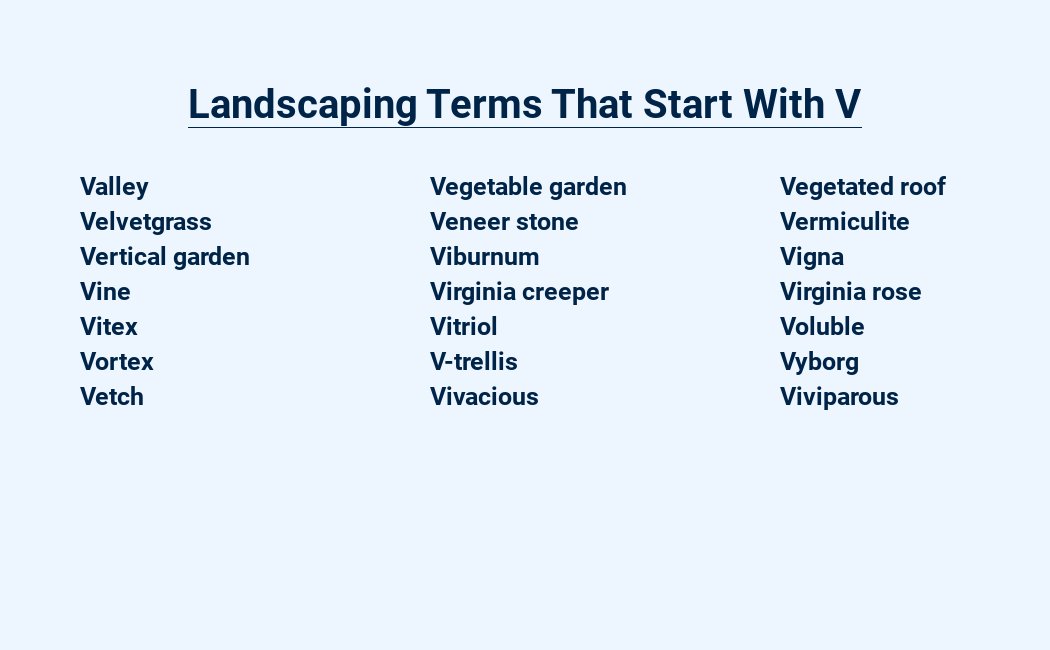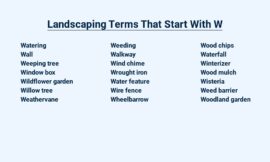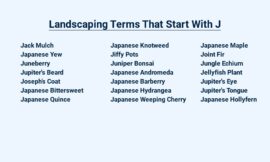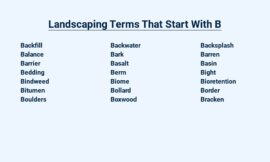Uncover the world of landscaping with terms that start with the letter V.
Dive into the art of vertical gardening, where plants ascend walls and structures, adding a touch of green to urban spaces.
Discover the beauty of vines, their tendrils reaching for the sky while adorning trellises and fences.
Explore the concept of vistas, panoramic views that captivate the eye, creating a sense of depth and perspective in your garden.
And watch out for voles, small rodents that can cause damage to your plants.
| Term | Definition |
| Variety | A group of plants that are similar in appearance but have distinct characteristics, such as different colors or growth habits. |
| Vein | A thin line or ridge on the surface of a leaf or flower petal. |
| Vertical climbing plant | A plant that grows upwards by attaching itself to a support, such as a trellis or wall. |
| Vigorous | Growing strongly and rapidly. |
| Vines | Plants with weak stems that grow by climbing or trailing. |
| Vining plant | A plant that grows by climbing or trailing, such as a morning glory or grapevine. |
Vertical Garden: A garden that is grown on a vertical surface, such as a wall or fence, rather than on the ground.
Versatile: Able to adapt to different conditions or situations. A versatile plant is one that can tolerate a wide range of soil and climate conditions.
Vigorous: Strong and healthy. A vigorous plant is one that grows quickly and produces an abundance of flowers or fruit.
Visual Interest: The quality of a landscape that makes it visually appealing. Visual interest can be created by using a variety of plants, colors, and textures.
Void: An empty space in a landscape. Voids can be created by removing plants or structures, or by simply leaving an area undeveloped.
Vulnerable: Susceptible to damage or harm. A vulnerable plant is one that is easily damaged by pests, diseases, or environmental conditions.
Landscaping Terms That Start with V
Vertical Gardening
Vertical gardening is a space-saving technique that involves growing plants vertically, often on walls or trellises. This method is commonly used in urban areas with limited space and is a great way to maximize growing capacity and add greenery to small spaces.
Vines
Vines: The Graceful Climbers of the Plant Kingdom
In the realm of landscaping, vines hold a prominent place, adding vertical dimension, texture, and color to gardens and outdoor spaces. These captivating plants gracefully ascend walls, fences, trellises, and pergolas, creating a sense of height and visual interest.
- Vertical Accents: Vines lend a vertical element to landscapes, breaking the monotony of horizontal lines and adding a sense of depth. They soften the edges of structures, transforming dull walls into vibrant green canvases.
- Texture and Color: Vines introduce a variety of textures and colors into the landscape. From the delicate tendrils of ivy to the lush foliage of climbing roses, vines offer a wide spectrum of visual appeal. Their blooms, whether vibrant or subtle, add pops of color and attract pollinators.
- Privacy and Screening: Vines can serve as natural privacy screens, effectively concealing unsightly views or creating secluded spaces. They can also provide shade and shelter, making them ideal for pergolas and patio covers.
- Maintenance Considerations: While vines can be easy to care for, some varieties may require regular pruning and training to keep them under control. It’s important to choose vines suitable for your climate and growing conditions to ensure their health and longevity.
- Popular Vine Varieties:
- Ivy: A classic vine with evergreen foliage, perfect for covering walls and fences.
- Climbing Roses: Known for their fragrant blooms and elegant appearance.
- Wisteria: A vigorous vine with cascading purple or white flowers.
- Clematis: A diverse group of vines with a wide range of flower colors and shapes.
- Honeysuckle: A fragrant vine with tubular flowers that attract hummingbirds.
Vines bring life and movement to landscapes, adding beauty and functionality. Their ability to climb and cling to structures makes them ideal for small spaces and vertical gardening.
With careful selection and proper care, vines can transform ordinary landscapes into enchanting havens.
Vista
A vista is an extensive, sweeping view of a distant landscape, often framed by trees or other natural features.
It is a focal point in landscaping, providing a sense of depth and perspective to an outdoor space.
Vistas can be created through careful placement of plants, trees, and other elements, and can be used to highlight specific features of the surrounding landscape.
Voles
Voles are small rodents that can cause significant damage to landscapes by feeding on roots and stems of plants.
They are often found in areas with dense vegetation and can be difficult to control.
Voles can also carry diseases that can be transmitted to humans and pets.
Final Verdict
Conclusion
In the realm of landscaping, terms commencing with the letter “V” encompass an array of fundamental concepts and elements. From the vertical allure of living walls to the intricate networks of vines, these terms highlight the diverse aspects of garden design and maintenance.
Understanding these concepts, from vistas that frame the landscape to the challenges posed by voles, empowers homeowners and landscapers to create harmonious and sustainable outdoor spaces.
By embracing the “V” vocabulary of landscaping, individuals can cultivate vibrant and visually captivating environments that seamlessly blend form and function.




